This guest post was written by Christopher M. Graney.
Occasionally science outreach works and expands the audience of people attentive to science. One such occasion was on the evening of December 9, 2015, in Louisville, Kentucky. The Louisville Chapter of Sigma Xi sponsored a program at the Louisville Free Public Library that drew 600 people. They came to hear two scientists from two different centuries speak. The event was titled: “Beneath the Same Sky: A Vatican Astronomer and a Civil War General Speak to Louisville about the Heavens.”

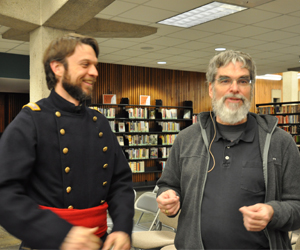 One of our speakers was Dr. Guy Consolmagno, a Jesuit Brother who Pope Francis recently appointed Director of the Vatican Observatory and who has written some very popular books on astronomy, including Turn Left at Orion (with Dan Davis), and most recently Would You Baptize an Extraterrestrial? (with Father Paul Mueller, SJ). The other was Kentucky-born Ormsby Mitchel, founder of the Cincinnati Observatory and a General in the Union Army in the Civil War (Mitchel was portrayed by teaching artist Tony Dingman of the Frazier History Museum).
One of our speakers was Dr. Guy Consolmagno, a Jesuit Brother who Pope Francis recently appointed Director of the Vatican Observatory and who has written some very popular books on astronomy, including Turn Left at Orion (with Dan Davis), and most recently Would You Baptize an Extraterrestrial? (with Father Paul Mueller, SJ). The other was Kentucky-born Ormsby Mitchel, founder of the Cincinnati Observatory and a General in the Union Army in the Civil War (Mitchel was portrayed by teaching artist Tony Dingman of the Frazier History Museum).
Dingman spoke first as Mitchel, describing the vast scale of the universe in a speech closely based on one given in 1847 by the real Mitchel. He noted that the universe was comprehensible by human beings, being governed by laws we can understand. Of the universe and its laws he stated, “God has given us these works for our examination, and He has given us this intellect by which we are enabled to comprehend their structures; and it is by this that we are able to rise—to climb—to soar, by our own efforts and by His aid.”
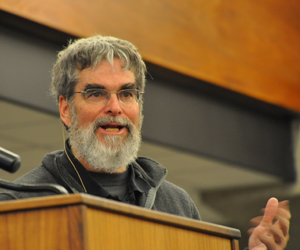 Consolmagno spoke about the Vatican Observatory and about the nature of science, focusing on ideas from the history of astronomy that were “almost correct”—ideas which ranged from the relationship between comets and meteor showers to the nature of the moons of Jupiter. “Sometimes,” he said, “science makes its most significant progress when it’s almost correct—which is to say, when it’s wrong.” He took questions from the audience, ranging from whether the recent flyby of Pluto changed his mind about the dwarf planet (he was on the committee that recommended that Pluto no longer be classified as a planet) to how he fit together his scientific knowledge and the book of Genesis. The speakers were regularly interrupted by laughter and applause, and the comments that both the library and our chapter received were unanimously positive.
Consolmagno spoke about the Vatican Observatory and about the nature of science, focusing on ideas from the history of astronomy that were “almost correct”—ideas which ranged from the relationship between comets and meteor showers to the nature of the moons of Jupiter. “Sometimes,” he said, “science makes its most significant progress when it’s almost correct—which is to say, when it’s wrong.” He took questions from the audience, ranging from whether the recent flyby of Pluto changed his mind about the dwarf planet (he was on the committee that recommended that Pluto no longer be classified as a planet) to how he fit together his scientific knowledge and the book of Genesis. The speakers were regularly interrupted by laughter and applause, and the comments that both the library and our chapter received were unanimously positive.
The full program can be viewed on Youtube.
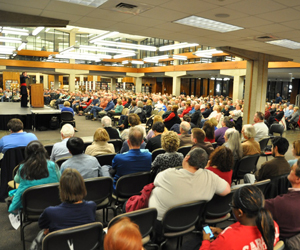 Our chapter wanted a program to raise Sigma Xi’s profile in the community, attract new members, and revive lapsed members. That meant a program featuring a noted scientist who would generate broad interest. Consolmagno is such a scientist. He has appeared on The Colbert Report. He received the American Astronomical Society’s 2014 Carl Sagan Medal for his ability to communicate with the public. Moreover, with the popularity of Pope Francis and the heavy media coverage of his recent U.S. visit, a Vatican astronomer seemed likely to draw interest (but we never expected to draw 600 people). Mitchel added a local connection and has also been compared to Sagan for his communication ability.
Our chapter wanted a program to raise Sigma Xi’s profile in the community, attract new members, and revive lapsed members. That meant a program featuring a noted scientist who would generate broad interest. Consolmagno is such a scientist. He has appeared on The Colbert Report. He received the American Astronomical Society’s 2014 Carl Sagan Medal for his ability to communicate with the public. Moreover, with the popularity of Pope Francis and the heavy media coverage of his recent U.S. visit, a Vatican astronomer seemed likely to draw interest (but we never expected to draw 600 people). Mitchel added a local connection and has also been compared to Sagan for his communication ability.
I made the acquaintance of both astronomers through my research on astronomy’s history. A focus of that research has been the seventeenth-century astronomer Giovanni Battista Riccioli. He studied gravity, gave lunar features the names we now use, and assembled strong scientific arguments against the Copernican system. He was also a Jesuit, which led me to a modern Jesuit astronomer: Consolmagno.
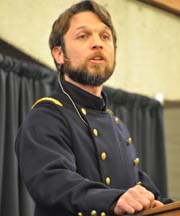 Acquaintance with Mitchel came through a conference at the University of Notre Dame this past summer. There Trudy Bell, an editor with Sky & Telescope, talked on Mitchel and his speaking ability. That brought to mind the Frazier History Museum. Their teaching artists excel at portraying historical figures using their own words. Long-standing contacts with the library and the Frazier, and the support of my college, brought it all together.
Acquaintance with Mitchel came through a conference at the University of Notre Dame this past summer. There Trudy Bell, an editor with Sky & Telescope, talked on Mitchel and his speaking ability. That brought to mind the Frazier History Museum. Their teaching artists excel at portraying historical figures using their own words. Long-standing contacts with the library and the Frazier, and the support of my college, brought it all together.
The program succeeded partly because of the partners—the Frazier and the library both had extensive community contacts. We also used chapter funds for advertising. But the biggest reason for its success was the speakers, who were scientists with “crossover appeal,” bringing in people whose interests lay in the areas of history, religion, oratory, and even theater (Dingman is known in the Louisville arts scene) as well as science.
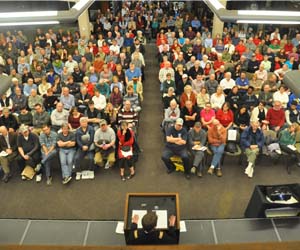 Two other points are worth mentioning. The library had to limit the number of tickets (free) given out for the program because of space concerns. Otherwise, the crowd would have been larger. Also, this is not our chapter’s first program to draw hundreds of people: in 2011 we packed the local planetarium to beyond overflowing with another science-and-history talk.
Two other points are worth mentioning. The library had to limit the number of tickets (free) given out for the program because of space concerns. Otherwise, the crowd would have been larger. Also, this is not our chapter’s first program to draw hundreds of people: in 2011 we packed the local planetarium to beyond overflowing with another science-and-history talk.
Thus the experience of our chapter suggests that one way to find success in science outreach and in expanding the audience of people attentive to science is to form partnerships with local institutions, to feature serious science speakers who also appeal to people with other interests, and to include history!
Christopher M. Graney is president of the Sigma Xi Louisville Chapter, a physics and astronomy professor at Jefferson Community & Technical College in Louisville, and author of the new book Setting Aside All Authority: Giovanni Battista Riccioli and the Science Against Copernicus in the Age of Galileo (University of Notre Dame Press, 2015). Pictures courtesy of Larry Gettleman, the Louisville Chapter's treasurer.
Photo captions
1st photo: The event's two speakers were Tony Dingman of the Frazier History Museum, left, who portrayed a Civil War general who founded the Cincinnati Observatory, and Guy Consolmagno, who Pope Francis recently appointed director of the Vatican Observatory and who has written books on astronomy.
2nd photo: Guy Consolmagno spoke of the Vatican Observatory, the nature of science, and ideas in history that were "almost correct."
3rd photo: Tony Dingman presents to the audience of 600 people that came to the Louisville Free Public Library to hear about science and history.
4th photo: Tony Dingman spoke first as Civil War General Ormsby Mitchel, describing the vast scale of the universe in a speech closely based on one given in 1847 by the real Mitchel.
5th photo: The Louisville Free Public Library, which hosted the event, offered free tickets to make sure they had enough space for the audience.